New products at Crocus
by Sarah - September 23rd, 2010.Filed under: Crocus, New Products.
Crocus just added these new items
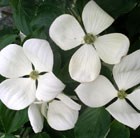
flowering dogwood £59.99
Position: full sunSoil: fertile, humus-rich, well-drained, neutral to acid soilRate of growth: averageFlowering period: May to JuneHardiness: fully hardyRecently hybridised in the US by Dr. E Orton, this new dogwood is the result of crossing Cornus nuttallii and Cornus kousa var. chinensis. The result is a beautiful small tree that is very tough and undemanding, has good drought tolerance and a high resistance to diseases. Its most striking feature however is the size of its creamy white bracts, which appear for several weeks from mid to late May. These are extremely large and can grow up to 15cm across, which creates a spectacular show, especially as they are usually produced in large numbers once the plant has become established. On more mature plants, these ‘flowers’ may be followed by large, strawberry-like fruits. This tree has the added bonus of providing spectacular autumn colour, when the large, glossy green leaves take on rich shades of yellow, orange and purple. Its compact habit and many interesting features make it a stunning focal point in a smaller garden.Garden care: Incorporate a good amount of well-rotted leafmould when planting. Requires minimal pruning.

Judas Tree £54.99
Position: full sunSoil: moist, well-drained soilRate of growth: slow-growingFlowering period: March to AprilFlower colour: pinkOther features: ideal for a warm, Mediterranean garden or on a south-facing bankHardiness: very hardyA lovely spreading tree that is often seen with multiple stems. Glaucous heart-shaped leaves appear after the flowers and turn pale yellow and brown in autumn. It is a lovely small tree for a warm, south-facing spot as it needs the heat to ripen the new shoots each summer to flower well the following spring. The pink blooms appear well before the leaves, and after a particularly warm summer, can cover the entire tree from the shoot tips to right down the trunk.Garden care: Plant in their final location when young as they resent being transplanted. Requires minimal pruning. Remove any broken, diseased or crossing branches in late autumn or winter. When planting incorporate lots of well-rotted garden compost in the planting hole and stake firmlyGoes well with: Kolkwitzia amabilis ‘Pink Cloud’, Ceanothus x delileanus ‘Topaze’, Lavatera ‘Barnsley’, Verbena bonariensis, Perovskia ‘Blue Spire’, Ruta graveolens, Dianthus caryophyllus, Stachys officinalis
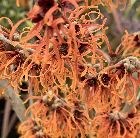
witch hazel £54.99
Position: full sun or partial shadeSoil: moderately fertile, moist, well-drained neutral to acid soilRate of growth: slow-growingFlowering period: January to FebruaryHardiness: fully hardyIn winter, this vase-shaped, deciduous shrub has clusters of sweetly scented, fiery orange flowers clinging to bare twigs. In autumn, the bright green leaves turn spectacular shades of yellow, orange and red. The tiered branches of this award-winning variety of witch hazel contrast well with the vertical stems of dogwood. A lovely specimen plant for a sunny winter border or woodland edge, where its perfume can be appreciated. The flowering twigs can be cut to perfume rooms in winter.Garden care: In early spring remove any misplaced, crossing or diseased branches and apply a generous 5-7cm (2-3in) mulch of well-rotted compost or manure around the base of the plant.
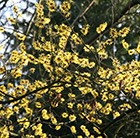
witch hazel £54.99
Position: full sun or partial shadeSoil: fertile, moist but well-drained, acidic to neutral soilRate of growth: averageFlowering period: January to FebruaryFlower colour: yellowOther features: will also tolerate deep, humus-rich soil over chalkHardiness: fully hardySpidery, yellow flowers cover the bare branches on this strong-growing witch hazel. The large blooms are extremely frost-resistant and highly fragrant, and appear from mid- to late winter. In autumn, the bright green leaves turn vibrant shades of orange and yellow. This is a lovely shrub for the woodland garden or as a specimen in the shrub border. Garden care: Minimal pruning is required. Remove misplaced, dead or diseased branches in late spring and apply a generous 5-7cm (2-3in) mulch of well-rotted garden compost or manure around the base of the plant.
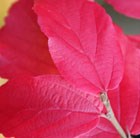
Persian ironwood £49.99
Position: full sun or partial shadeSoil: moist, well-drained soil, preferably acidicRate of growth: fast-growingFlowering period: January to FebruaryHardiness: fully hardyIn autumn, this deciduous tree is a breathtaking sight, as its large, smooth, wavy-edged leaves turn brilliant yellow, then orange and finally blaze fiery red before falling. In late winter and early spring, insignificant, spidery, red flowers appear before the leaves. Persion ironwood is a spreading tree, with a short trunk and peeling grey and fawn bark. As it normally has multiple stems, it is best grown as a large shrub in the border or in an open woodland garden. It can get very big, so it is best suited to larger gardens.Garden care: Requires minimal pruning. Remove any broken, diseased or crossing branches in late autumn or winter. When planting incorporate lots of well-rotted garden compost in the planting hole and stake firmly.
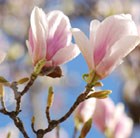
magnolia £49.99
Position: full sun or partial shadeSoil: moist, well-drained, acidic soilRate of growth: averageFlowering period: April to MayHardiness: fully hardyOne of the most popular magnolias, with large, dark green leaves that start to appear in mid spring, at about the same time as the huge, deep rose-pink or white, goblet-shaped flowers. This is a good magnolia for smaller gardens,as it remains a shapely shrub for many years, and even when it is mature, is a manageable small tree.Garden care: Requires minimal pruning. Remove any broken, diseased or crossing branches in midsummer. The best time to plant is in April, adding plenty of peat to the planting hole, in a sheltered spot. Mulch in spring with manure and leafmould, especially on dry soils.
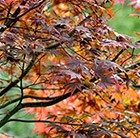
Japanese maple £49.99
Position: full sun (but not south-facing)Soil: fertile, moist, well-drained neutral to acid soilRate of growth:slow-growingFlowering period: April to MayHardiness: fully hardyAn elegant small tree, with deeply lobed dark purple-red leaves that turn fiery red in autumn, and tiny purple flowers in spring. This neat, slow-growing acer has an open habit, and looks dramatic silhouetted next to buildings, as a focal point in a small courtyard, or in a Japanese-style garden. It needs a sheltered spot, away from strong winds or all-day sunshine. It also looks good in a container.Garden care: Add a top-dressing of a well-balanced fertiliser around the base of a recently planted tree in late spring and keep it well watered. No routine pruning is required, just remove any dead, damaged or crossing branches in late autumn or winter when they are fully dormant.
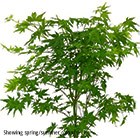
Japanese maple £44.99
Position: partial shadeSoil: fertile, moist, well-drained neutral to acid soilRate of growth: slow-growingFlowering period: April to MayOther features: red winged fruit in late summerHardiness: fully hardyThe beautiful, deciduous foliage of this small, round-headed tree is attractively lobed and turns from its usual mid green in autumn to take on shades on yellow, orange and red before it falls. In late spring tiny purple-red flowers are borne in small pendulous clusters and are followed in late summer by charming winged fruits, which float down from the branches when they are ripe.Garden care: Add a top dressing of a multi-purpose fertiliser around the base of the plant in late spring. No routine pruning is required, just remove any dead, damaged or crossing branches in late autumn or winter when they are fully dormant.
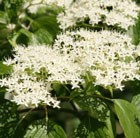
dogwood £39.99
Position: full sun to part shadeSoil: deep, fertile, moisture-retentive soilRate of growth: slow-growing to averageFlowering period: JuneFlower colour: whiteOther features: the fruits may cause a mild stomach ache if ingestedHardiness: fully hardyLarge clusters of white flowers in June, followed by spherical, blue-black fruit, and glossy, dark green leaves, turning rich red and purple in autumn. The horizontally tiered spreading branches of this deciduous dogwood provide an excellent focal-point for a medium-sized garden. Rounded in shape, it performs best in fertile, moisture-retentive soil in full sun. Garden care: Incorporate a quantity of well-rotted garden compost or horse manure in the planting hole to improve the moisture-retentive qualities of the soil. The tree requires no regular pruning, since this would interfere with its graceful, tiered habit.
smoke bush £39.99
Japanese snowball bush £39.99
magnolia £39.99
dogwood £39.99
flowering dogwood £39.99
silver bell £37.99
viburnum £34.99
hydrangea £34.99
enkianthus £34.99
oleaster £34.99
Plus…
13 products from Garden | shrub
6 products from Garden | Bulbs
5 products from Garden | perennial
1 products from Home






